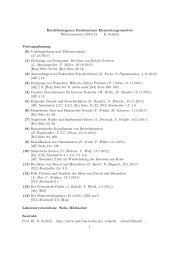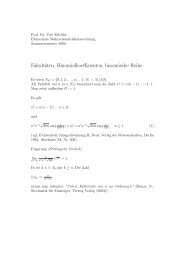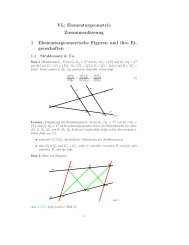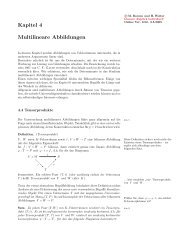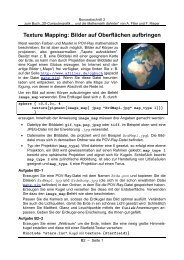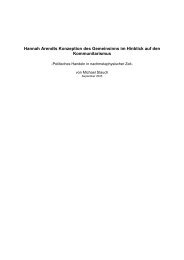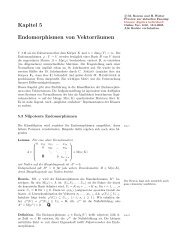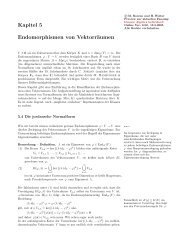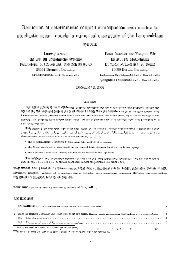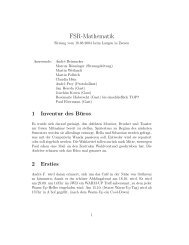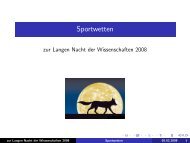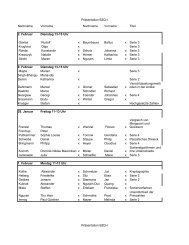Nicolas Roy's Curriculum Vita - Institut für Mathematik - Humboldt ...
Nicolas Roy's Curriculum Vita - Institut für Mathematik - Humboldt ...
Nicolas Roy's Curriculum Vita - Institut für Mathematik - Humboldt ...
You also want an ePaper? Increase the reach of your titles
YUMPU automatically turns print PDFs into web optimized ePapers that Google loves.
periodicorbits. This1-formadmitsanintegralexpressioninvolvingonlytheflowof H0,but<br />
which is in general divergent. We give several ways to treat this divergence problem and<br />
we explain whyit doesapparentlynot appearin the above-mentionned particular models.<br />
[5] Asemi-classicalK.A.M. theorem<br />
We consider a semiclassical completely integrable system defined by a pseudodifferential<br />
operator ˆH, with small parameter ¯h, on the torus T d , whose total symbol is a classicaly<br />
completely integrable Hamiltonian H ∈ C ∞ T ∗ T d . We study perturbed operators of the<br />
form ˆH + ¯h κ ˆK, where ˆK is any pseudodifferential operator and κ > 0, and we show the<br />
existence ofsemiclassical normal forms forthese operators. Thisisused toconstruct a large<br />
number of quasimodes, in analogy with the K.A.M theorem in classical mechanics which<br />
proves the persistency of a large number of invariant tori after perturbation. Moreover, the<br />
first correction to the eigenvalues is related to the average of the symbol of the perturbation<br />
ˆK. In order to prove these result, one needs to perform a very precise analysis of the<br />
resonances and the diophantine tori with parameters dependingon ¯h.<br />
[4] Ruelle-Pollicottresonancesfor realanalytic hyperbolicmaps<br />
Weconsider two simplemodelsof uniformly hyperbolic dynamical systems : expansive<br />
maponthecircleS 1 andhyperbolicmaponthetorus T 2 ,andwestudythedecayoftimecorrelation<br />
functions, which isfundamental to establish other chaotic properties of the system.<br />
To achieve this, we study the Ruelle transfert operator ˆM defined as the pull-back operator<br />
ˆM (ϕ) = ϕ ◦ M, where M is a chaotic real analytic map on S 1 (resp. T 2 ) and ϕ ∈ L 2 S 1<br />
(resp. ϕ ∈ L 2 T 2 ). We show that the Ruelle-Pollicott resonances, which describe the time<br />
correlation functions Cϕ,φ (n) = ϕ. ˆM n (φ) dx, with n ∈ N, can be obtained as the eigenvalues<br />
of a trace class operator on L 2 S 1 (resp. L 2 T 2 ). We show moreover that these<br />
resonances accumulate exponentiallyfast on 0.<br />
[6] ASemi-classicalapproachfor Anosov diffeomorphismsand Ruelle resonances<br />
If f is an Anosov diffeomorphism on a compact manifold, the decay of the dynamical<br />
correlation functions is governed by the so-called Ruelle resonances. It follows from the<br />
works of Baladi & al and Liverani & al, that these resonances can be obtained by a suitable<br />
spectral analysisofthecomposition operator (oranotherone relatedto it)calledthe "Transfer<br />
operator". In this paper, we show how these results can be obtained by a systematic<br />
microlocal analysis, extending the approach of the previous work [4].<br />
[7] Thegeometryofthe spaceof fibrations<br />
We study geometrical aspects of the space of fibrations between two given manifolds<br />
M and B, from the point of view of Frechet geometry. As a first result, we show that any<br />
connected component of this space is the base space of a Frechet-smooth principal bundle<br />
with the identity component of the group of diffeomorphisms of M as total space. Second,<br />
weprovethatthespaceoffibrationsisalsoitselfthetotalspaceofasmoothFrechetprincipal<br />
bundle with structure group the group of diffeomorphisms of the base B.<br />
6



